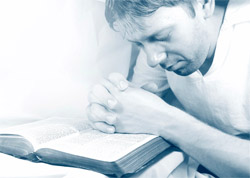Christopher Nolan's The Dark Knight: This Present Darkness

Editor’s Note: This article is a look at the political and social allegory of The Dark Knight. Because it looks at some of the intricacies of the film’s story, some plot points and spoilers are referenced.
The Gotham City of Christopher Nolan’s The Dark Knight isn’t really a dark place; it’s more of a hazy shade of grey. Criminals and heroes are sometimes hard to tell apart behind masks and false identities, and when justice doesn’t come at the hands of the corrupt police department, it comes from Batman, a lone vigilante who is willing to let nothing (including the law, personal property and ethical dilemmas) stand in his way of getting the bad guy.
It would be a mistake to say The Dark Knight is just a comic book movie. No, this is a cold look at post-9/11 America and how we view right and wrong in a world gone mad. And with a plot that analyzes everything from torture to wiretapping, the allegory is thick.
For those unfamiliar with Batman lore, the story picks up just after the origins tale of 2005’s Batman Begins (the re-inspired epic that revived the franchise) that follows the billionaire Bruce Wayne, battling his own demons to become a disguised force of good in his city.
But time has passed since the Caped Crusader first took to the streets fighting crime, and Gotham is in for dark times as a new criminal strolls into town. The psychotic Joker (played by the late Heath Ledger) isn’t just a crook—he’s a terrorist. Ripping off the mob and burning piles of money, the Joker isn’t out to steal from the citizens of Gotham; he’s out to destroy their way of life. Nothing (including his own life) matters to this agent of chaos. He’s not out for money or power like the villains of the past—he’s out for converts.
Blowing up a hospital, planning assassinations and kidnapping city officials, the Joker wants people to abandon their values and let raw emotions like terror and self-preservation overtake them.
The Joker engages in his own crime spree that puts citizen against citizen with sadistic games of morality (Would you kill a single man if it would save an entire hospital? Would you blow up a ferry carrying convicts if you could save your own ferry full of passengers?), and given the choice, he’d rather see you corrupted than killed. Though the Joker’s violent sprees are gruesome, his real weapons are the fear and paranoia that begin to breakdown the foundations of Gotham’s urban society.
In the meantime, an idealistic District Attorney named Harvey Dent rises to power, fighting the bad guys in the courtroom as Batman does the dirty work in back alleys. But when the violence hits home, even Dent proves to be susceptible to the entanglements of vengeance and fear. There’s a point in the film where the Joker, seeing Batman observe Gotham’s plunge into chaos, tells him, “Look what I’ve been able to do to your city with just a little bit of gasoline and just a few bullets.”
As Gotham plummets into chaos, Batman takes matters into his own hands. On the outside, Bruce Wayne, Batman’s alter ego has every stereotypical American trait: he’s rich, proud and powerful—the kind of guy who throws a party that everyone wants to come to, but where all the guest are making fun of him behind his back. But beneath the surface, Wayne is fighting the same internal battle that the citizens of Gotham are facing.
Like America in the war on terror, Gotham isn’t a city being eroded by greed. This is no traditional war. This is a story about a battle of ideals—and why sometimes, in order to preserve them, you’ll betray them.
Batman’s inner conflict unfolds like the last seven years of American politics concerning the war on terror. At one point, the Joker tells Batman that he will kill civilians everyday until he reveals his true identity. The Joker promises that as soon as Batman ends his vigilante campaign, the killings will stop. Like Congress debating a pull-out of Iraq in hopes of ending the loss of innocent life at the hands of insurgents, Batman too is faced with an impossible decision—stop his fight and see if the Joker will stop the killing, or fight on, even if he believes the blood is now on his hands too.
When the Joker hides away with the detonator of bomb, Batman (despite the protest of his sidekick about the unethical violation of privacy) taps every cell phone in the city with a secret sonar device to find him. Wiretapping be darned—Batman’s concern isn’t civil privacy; it’s security. Sound familiar?
There’s even a scene when he violates his own code and resorts to locking the Joker in a holding cell in an unsuccessful attempt to beat the truth out of him. All that was missing was a waterboarding apparatus.
With all his money, superior technology and political clout, Batman stands no chance against the mind-game the Joker is playing with the terrified citizens of Gotham. An underlying political theme of the movie is essentially this: In a war against terrorists (who aren’t out for money), wealth and technology are meaningless—this is a battle for the minds of the people.
And as Batman finds out, winning that war takes sacrifice, especially when the going gets tough. In the last scene of the film, seeing no other option than making himself the scapegoat for the causalities of the fight against evil, Batman—broken and bleeding—tells the police commissioner to unleash the dogs, and let the public believe his misguided justice is behind the madness.
He finds out that the only thing more powerful than a society living in fear, is a society united in a cause.
In the end, he had to make himself a part of the cause he has spent his life fighting against. Harvey Dent had warned him, “You either die a hero, or live long enough to see yourself become the villain” —at least by outward appearance.
Like a lone cowboy of riding into the sunset after a grisely shootout, Batman realizes that in the fight against true evil, in the end, even the good guys start to look pretty bad.





